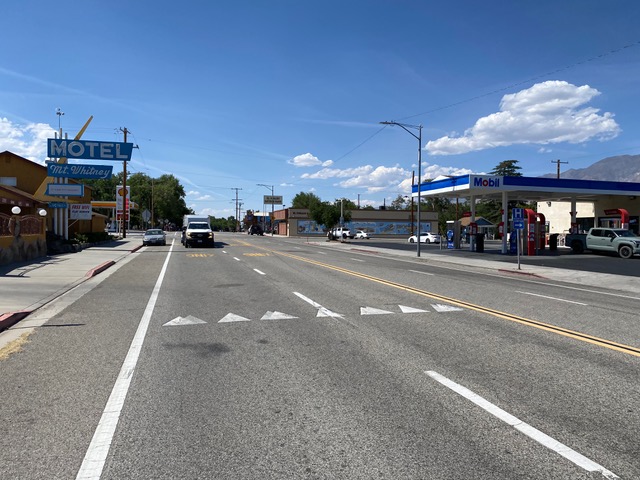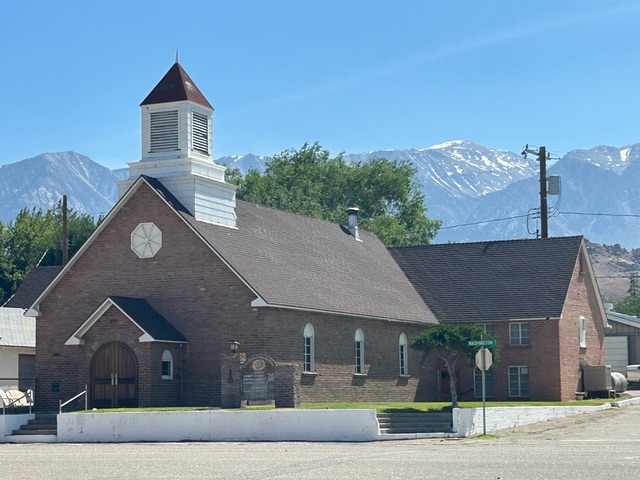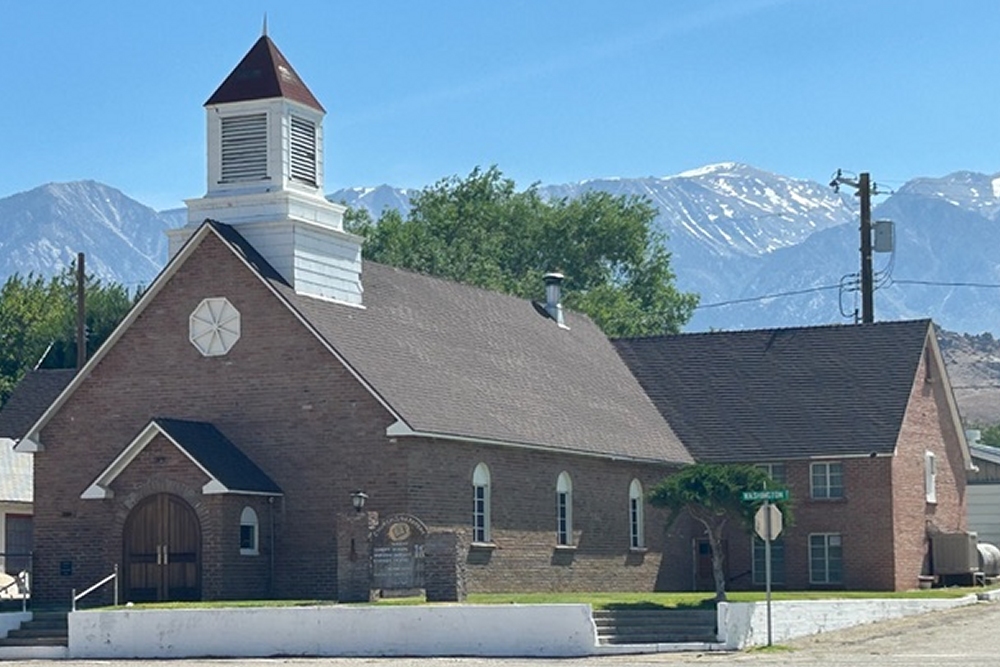In Whitney’s shadow
From Yosemite National Park to Death Valley – and right through chess history
This June, I had the pleasure of enjoying a wonderful holiday in the southwest of the United States with my wife. From San Francisco, we visited the major national parks in California, Nevada, Utah and Arizona, gaining unforgettable impressions along the way. Such a trip involves long drives, as the parks are far apart. It’s easy to end up passing many interesting places on the way from one park to the next. That almost happened to me as we were driving along Highway 395 from Yosemite National Park to Death Valley and passed the following town sign.

Town sign of Lone Pine
When I saw the sign, something clicked. There was something familiar! Weren’t there chess tournaments held in a place called Lone Pine? But were they held here or in another town with the same name?
At first glance, the small town (today with around 2,000 inhabitants) looks quite unremarkable. The town centre is essentially Highway 395, lined with the usual petrol stations, fast food outlets and budget motels typical of small-town America. Moreover, it lies in the middle of nowhere. The nearest big cities are Los Angeles or Las Vegas, each about a four-hour drive away. There’s no airport or train station in the area. It’s hard to believe that in the 1970s and 1980s, some of the strongest chess tournaments in the United States were held here, even attracting grandmasters from Europe and South America.

The main street of Lone Pine
But a quick look at Wikipedia confirmed that I was indeed in the right place. So I began to follow the traces of chess history.
The first thing I realised was that Lone Pine has more to offer than one might expect at first glance. The town lies at the foot of the Sierra Nevada, a mountain range in eastern California. This range includes Mount Whitney, which at 4,412 metres is the highest mountain in North America outside Alaska. Chess.com user Badgirl (Winter 2017) therefore fittingly referred to the tournaments as being “in Whitney’s shadow”.

View from Lone Pine to the Sierra Nevada. Mount Whitney is the snow-covered peak to the left of the power line.
I then went in search of the former tournament venue. In a small town like this, it was easy to find. From 1975 onwards, the Lone Pine Town Hall was the playing venue, and it still looks almost exactly the same as it did 50 years ago.

Left: The Town Hall in the 1970s (source: Winter, 2017); right: a recent photo by the author
On the wall to the right of the entrance, you can find the following dedication.

This dedication takes us directly to the sponsor of the tournament.
Louis Statham – Inventor and chess patron
The initiator and sponsor of these tournaments was Louis D. Statham, a wealthy inventor of medical devices (including the Statham pressure transducer used for blood pressure measurement). Wanting to escape the hectic life of Los Angeles, he sold his villa there to Hugh Hefner (who built the Playboy Mansion on the site) and moved to Lone Pine.
This video course provides a comprehensive and practical White repertoire in the Ruy Lopez! Through instructive model games and in-depth theoretical explanations, you will learn how to confidently handle both main lines and sidelines.
Free video sample: Introduction
Free video sample: Overview
Free video sample: Chigorin: 9…Na5 10.Bc2 c5 11.d4 Nd7/cxd4

Louis Statham in the 1970s. Source: (Waterman, 2009)
In Los Angeles, he was active as a chess patron, and he continued this role in Lone Pine. His goal was to give the strongest US juniors the opportunity to compete against strong grandmasters. To this end, he organised a total of 11 tournaments between 1971 and 1981, which became stronger each year.
To provide the best possible playing conditions, he built the Lone Pine Town Hall in 1975. This building was designed to also serve the needs of the local administration, and it still does so today. After his death in 1983, the building was renamed Statham Hall in his honour.
A tournament for the history books: Lone Pine 1977
With eleven tournaments held in Lone Pine, it’s not easy at first glance to pick out just one. In this case, however, it was relatively easy, as history was made at this tournament. In the 1977 event, the Georgian grandmaster Nona Gaprindashvili became the first woman ever to achieve a GM norm.
Tournament director Isaac Kashdan published a detailed report on this event in Chess Life (Kashdan 1977), from which I have taken the following final standings table.

Final standings of the Lone Pine 1977 tournament. Source: (Kashdan, 1977)
As can be seen, Nona Gaprindashvili finished strongly, winning her final three games. With 6½ points in 9 rounds, she shared first place and fulfilled the GM norm. Looking at her games from the tournament, one might say that Caissa smiled on her in a few instances. But I particularly liked her finish in round one against Martinovsky.
At first glance, it looks like Black has good counterplay on the queenside and that the white king isn’t entirely safe. But with her next move, 26.Nb5, Nona shows she has everything under control. The justification for this move becomes clear after 26…Rxa2 27.Bxd2, and the black queen has no more squares. Black tried to muddy the waters with 27…c4, but after 28.Bxb4 cxd3+ 29.Kb1, the exchange – and shortly after the game – was lost.
Her performance was not only impressive from a chess perspective – it also had societal impact. Even the Dutch chess publicist J.H. Donner, known for his provocatively chauvinistic remarks about women’s chess, publicly changed his stance (Donner, 2008):
There is no longer any doubt. Even in chess, there is now at least one woman who belongs among the world elite.
The following charming anecdote about the tournament is told by Larry Christiansen in one of his books (Christiansen, 2000):
There were some complaints that the beauty prize judge, tournament director Isaac Kashdan, preferred quantity over quality. For example, a simple rook or queen skewer sacrifice was favoured over more complex piece or pawn sacrifices. I once had a game against Eugene Meyer in which I had the choice of sacrificing either a rook or a queen to deliver mate, and I chose the queen – hoping to catch Kashdan’s attention. In fact, I received a beauty prize for that game, even though there were other games with much more intricate, if less flamboyant, combinations.
Here is the position where Larry Christiansen sacrificed his queen on h5 against Meyer.
The games referenced in the article can be replayed here.
Miscellaneous
While researching this article, I came across a whole range of interesting pieces of information that didn’t make it into the main part of the article but are still worth sharing.
If you want to get an impression of the Lone Pine tournaments and Louis Statham, you can watch the following film on YouTube. The plot of the film didn’t become entirely clear to me, but the first 5 minutes feature some nice footage from a tournament in Lone Pine and an interview with Louis Statham.
“>Video: The Great Chess Movie by Gilles Carle and Camille Coudari
The chess tournaments of Lone Pine have not left a lasting impression on the town. Most visitors to Lone Pine are just passing through or planning to climb Mount Whitney. But there is a third group. Since the 1920s, the area around Lone Pine has frequently been used as a filming location for well-known movies. The local Chamber of Commerce has published this overview map of some of these film locations.

Overview map of filming locations near Lone Pine (Source: https://lonepinechamber.org/)
It is only logical, then, that the Museum of Western Film History (https://museumofwesternfilmhistory.org/) is located in the town. A visit is well worth it. When you see the dentist’s wagon in the museum, you might think Christoph Waltz and Jamie Foxx are about to appear around the corner.

The Western Museum in Lone Pine. The travelling dentist’s wagon is from Django Unchained.
References
- Christiansen, L. (2000). Storming the Barricades: Lessons in Attacking Chess from a Top GM. London: Gambit Publications.
- Donner, J. H. (2008). The King. New in Chess.
- Kashdan, I. (1977, July). Lone Pine 1977. Chess Life, 32(7), 361–364, https://uscf1-nyc1.aodhosting.com/CL-AND-CR-ALL/CL-ALL/1977/1977_07.pdf
- Waterman, D., Grefe, J., & Gheorghiu, F. (2009). The Best of Lone Pine: The Louis D. Statham Chess Tournaments 1971–1980. Paperback.
- Winter, E. (2017, August 18). In Whitney’s Shadow. Chess.com. Retrieved 4 July 2025, from https://www.chess.com/article/view/in-whitney-s-shadow
